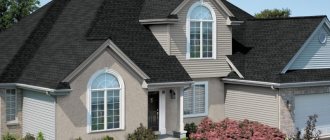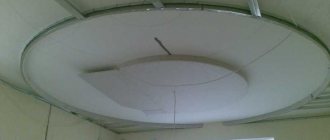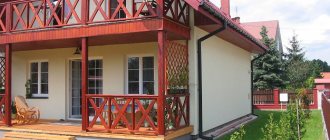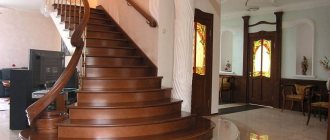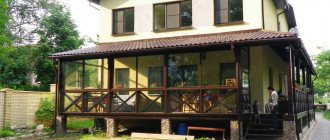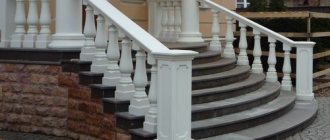What types of porch are there?
In addition to its functional qualities, the porch near a private house also performs a decorative function, being, in fact, the “face” of the entire house and enclosing the entire architecture.
Therefore, you should carefully think through the decor of the future structure in style in accordance with the rest of the structure, choosing the most suitable material for this.
In the numerous photos presented, it is easy to see certain dependencies: therefore, we will use a simple rule that says that “it is better to see once” than to delve into the intricacies of design art.
In general, there are three main classification criteria:
- By device type.
- According to the building materials used.
- By the presence/absence of a canopy or canopy over the porch.
In principle, it is not so important for us to know how a simple, attached and built-in porch differs from each other (the first classification criterion): it is clear that the built-in is an integral part of the house and is designed together with it, and there is no need to particularly understand the other two - that’s business professionals, it’s our business to build.
Of great practical interest to us is the second criterion, which distinguishes four types of porches depending on the material used:
- wooden;
- concrete;
- metal;
- brick/stone.
This is what we will deal with. All four types are good as a porch for a private house or country house, the only question is:
- a) in price,
- b) in your specific processing skills and preferences for a particular material,
- c) the material from which the house is built.
You shouldn’t, say, attach a concrete porch to a wooden house, while a wooden porch will fit on a building built from any material.
Yes, you can see for yourself in the pictures under what conditions it is better to build a porch from one material or another.
Therefore, let’s move directly to the issue of the design and technology of constructing each of the four types of porch, leaving for last the issues of arranging a canopy (canopy) for protection from precipitation and the hot sun.
Wooden porch
Let's start with a wooden porch, since wood is the most affordable material for most owners of a cottage or summer cottage.
Unlike metal or brick and concrete, we all (or almost all) made all kinds of crafts from birch bars and planks in childhood and youth, so it’s quite possible to handle this material even with basic skills in handling a hacksaw and a hammer with nails.
You will also need a square to accurately mark the corners (don’t be afraid of the calculations, here they will be elementary) and a simple pencil.
Several designs of wooden porch are available for independent execution, in particular, arrangement of steps. However, the most common and practical is based on the so-called. “stringer” (it is also sometimes called “string”).
A stringer is a support beam with corner cuts, on the plane of which steps are attached. The proposed diagrams and photos show that most often a thick and wide board is used for stringers.
Typically, the width of the stairs is at least 1.2 m. This means that to create a durable structure you will need 3 stringers with a half-meter distance between adjacent ones. You can also use four support beams if you want, which is not optimal, but overall stronger.
When building a wider staircase, calculate the number of stringers based on the 50-centimeter distance between them.
The best material to use is larch (this is ideal) or coniferous wood, which are more resistant to the damaging effects of moisture.
Additionally, the boards are treated with special impregnations that add strength and moisture resistance to them.
An important question that often does not arise for DIY beginners who are trying to build a porch for a house with their own hands in one way or another is the presence of an overhang on the steps, which prevents the accumulation of moisture on them after rain and freezing in the winter.
An overhang is a slight inclination of a step at an angle sufficient for water to drain and individual drops to roll freely.
The usual calculation for the amount of overhang is 1-2 cm per 1 meter, but since the width of the step does not exceed 40 cm (in reality - from 27 to 32 centimeters), such an angle is practically not felt underfoot and is perceived as strictly horizontal.
Another thing is where to ensure the water drains: in most cases you will see recommendations about the external slope, i.e. moisture flows from each stage to the previous one.
However, there is another opinion, which is to allow water to flow inward, into the space of the riser (if it is made closed, a gap three millimeters wide can be left for this purpose).
It is best to concrete the space under the steps and the upper platform of the porch. This provides a kind of foundation for the entire structure of the wooden porch, as well as providing a tidier space and diverting water running down the steps away from the foundation of the house.
- You will need to mix cement mortar at the rate of 1 bucket of cement to 3 buckets of sand, to which add 3-4 buckets of crushed stone for reinforcement.
When mixing, add water gradually so that the solution does not turn out to be too liquid. After the concrete composition has set, the surface is usually smoothed with a cement screed.
A small “life hack”: even before concreting the site, the stairs should already be ready. Then, during its installation, the lower ends of the stringers are pressed into the not completely hardened concrete solution and thus provide excellent support for the entire structure!
The upper platform of the porch - the one immediately in front of the front door of the house, is sheathed either with the same material from which the steps are made, or with a special decking board, which is produced with a special coating for use in conditions of year-round exposure to precipitation: the service life of the decking board exceeds (sometimes significantly) 20 years.
It is worth noting once again that the structural staircase of a wooden porch can be made in other ways, clearly recognizable in the photos presented, but the described design is perhaps the most popular and has proven itself well.
Concrete porch
A porch made of concrete is also often given preference over other technologies, especially by those who are somehow familiar with concrete work or are generally specialists in this matter.
Perhaps you are not such a specialist, but something attracts you with this particular method of building a porch near the house (for example, because of its solidity), which means it’s time to try your hand at working with this material.
When planning the construction of a porch made of concrete, you should keep in mind that its height, together with the steps, is equal to the height of the foundation of the house, and the porch itself is, as it were, a continuation of it.
However, a small layer of rock wool should be placed between the back surface of the concrete porch and the adjacent foundation surface. This is a deformation layer that prevents further cracking of the porch and relieves the load on the foundation.
The porch is built by pouring concrete mortar into wooden formwork. We discussed the composition of the solution above, but note that, in addition to crushed stone, to achieve optimal strength, additional reinforcement of the steps and upper platform with metal mesh will be required.
One of two methods of arranging formwork is usually used. The first method is a stage-by-stage casting of steps: the first part is the largest, occupies the entire area allocated for the porch and is always a couple of centimeters higher than all the other steps.
We do not spare material for reinforcement!
After the site has hardened, we build another, smaller one on it - we form steps, and so on to the entire height of the foundation.
The second method is to construct a complete formwork, recreating the outer frame of the entire porch. In this case, the process is relatively continuous, so a concrete mixer is required. It is important to make each step whole, in one pour.
And don’t forget about reinforcement with metal mesh or lattice! We smooth out all possible unevenness with cement mortar.
After the concrete has completely hardened (and this is about 10 days for a solid cast structure and about a week for each tier in the first of the described methods), using cement mortar or special glue for exterior work, finish the surfaces with non-slip (clinker) tiles or artificial stone in accordance with the instructions in advance. a well-thought-out plan.
Often the dimensions of the porch themselves are calculated based on the dimensions of the selected facing tiles, which is very reasonable and will allow you to avoid unnecessary cutting of tiles.
Metal porch
To work with metal, you will need the most special skills, and tools should be prepared for cutting metal (grinder) and welding it (a portable welding machine, which you need to know how to use), as well as an electric drill.
A simple metal porch to the house can be equipped without forged elements, which must be ordered in advance and a considerable amount of money must be prepared for the blacksmith for the work.
In the simplest and most accessible (but far from the only!) form, such a porch repeats the version of the porch of a wooden structure described by us, only a metal channel with L-shaped parts welded on it from a metal corner acts as a stringer.
- The length of the short part is the height between adjacent steps, the long part is equal to the width of the step or slightly less.
- The “stringers” channels are welded together with an angle along the width of the future porch, forming a rigid structure.
The steps can also be made from a metal sheet with stamping (usually herringbone) for rigidity, which, in our case, helps to better grip the sole of the shoe. However, this option is not very popular, since metal steps are usually noisy (the steps of a person walking on them echo loudly) and get very hot in the sun in summer.
More often, the material for the steps of a metal staircase is a thick wooden or porcelain stoneware board, which is screwed with two bolts to each corner of the “stringer”.
The upper landing is usually made of the same material as the steps. For reliability, they form a circle of cross-welded corners, the ends of which are welded to the support posts.
Before installing the steps and the upper platform, the entire structure, if necessary, is cleaned of rust, carefully primed with a special primer for metal and then painted with good paint using a brush or spray - whichever is more convenient, as long as it turns out well in the end.
It is worth noting that, if you have the materials and good skills in working with a welding machine, this is the fastest way to build a porch near the house, taking only a few hours, or a day at most.
The main thing is to first draw a detailed diagram and determine the exact number of individual parts and their sizes.
Concreting support columns, for which you can use a thick-walled metal pipe or the same channel, can slightly increase the total construction time.
Brick porch
To be honest, brick, as a material for building a porch near a house, does not have any special advantages. Brick for these purposes is chosen mainly in two cases:
- the owner is a bricklayer himself, has extensive experience in bricklaying and loves this familiar material;
- After construction there was a lot of brick left that needs to be used somehow.
The disadvantages of brick include the laboriousness of the laying process, painstakingness and constant monitoring of the level, and the lack of guarantees of a good result for an inexperienced homeowner who dares to pick up a trowel.
In addition, not every brick is suitable for our purposes. In general, silicate should be immediately crossed out from the list of materials under consideration, even if it is available in sufficient quantities: quite quickly it will begin to crumble, bringing the hour of repair, or even a complete redo of the porch, closer.
A red brick made of baked clay will do. By far the best option is clinker brick, which is unreasonably expensive for a porch.
It would be better if you “deceive” those around you a little by simply covering the surfaces of the concrete (or cinder block) porch with tiles imitating red or yellow brick, if you really want to implement the “brick” theme.
As a last resort, cover it with brick, initially leaving a tolerance in the dimensions for the brick.
By the way, natural stone is no better for building a porch. It is a strong and durable material, however, it requires a lot of experience and effort in processing so that it can be laid as tightly as possible without relying on filling the voids with cement mortar.
It is easier and more expedient to recreate the surroundings of a stone building by lining a concrete (cinder block) porch with facing stone.
But you finally decided to build a brick (stone) porch. In this case, you need to start from the foundation in order to balance the considerable load and prevent the destruction of the masonry due to uneven subsidence.
- To do this, you need to dig a hole in the ground in the shape of the future porch and to a depth of 10-20 cm, fill the bottom of it a quarter with sand and compact it, not forgetting to water it.
- Then a quarter is filled with gravel, thus creating a sand and gravel cushion, onto which the remaining volume is poured with a concrete solution of cement, sand and crushed stone in a ratio of 1/3/3-4.
- After the concrete has reliably hardened, you can begin laying the brick porch.
Staircase designs
There are two main designs of stairs: on bowstrings and on stringers. They can be made of wood or metal. There are also combined options - metal + wooden steps or metal + concrete steps.
Staircase designs - on bowstrings and on stringers
On the bowstrings
Stairs on bowstrings are the simplest. For a porch - a good option, especially if the house is wooden or a small country house. Support bars are attached to the inside of the bowstring. If you are working with metal, the bars are welded horizontally (with a minimum slope of 1-2° to allow water to drain from the steps). In the case of wood, support bars can either be nailed to which the step will then be attached, or recesses can be cut into the bowstring (no more than 1/2 the thickness of the board), into which the step boards are inserted.
On the stringers
A staircase on stringers can also be of a simple design - with open supports. In this case, triangles are cut at the required angle in the upper part of the board. Their lower part serves as a support for the steps.
Staircase on an open stringer
When cutting the stringer, set aside the height of the step and the width of the tread. They are connected at right angles. Using the applied markings, a template is made, with which all steps are marked.
The principle of cutting stringers
The number of stringers in a staircase depends on its width and the thickness of the boards used for the steps. The thinner the board for the steps, the more often you need to install stringers. If you use 25 mm boards, then there should be a distance of no more than 50-60 cm between the two supports. If you need a larger staircase width and don’t want to install three stringers, use thicker boards. It is important that they do not bend under your feet.
The procedure for assembling stairs on stringers
If you decide to weld a ladder on stringers from metal, you will need to be patient: you will have to weld many small sections, but the formation principle is the same.
Metal staircase on stringers
Methods of fastening parts
The lower edge of the porch stairs can sometimes rest directly on the ground. This option is simple, but unreliable. Firstly, the soil may settle and the stairs will begin to collapse. Secondly, upon contact with the ground, both wood and metal are destroyed faster. There are special impregnations for wood (Senezh and Senezh Ultra, for example), and metal is well prepared with a primer and painted in several layers. However, it is better to make a base - pour a shallow tape on which the bowstrings or stringers will rest.
How to Support a Porch Staircase
There are two ways to attach a porch ladder to a reinforced concrete base - to a beam - a beam with a cross-section of at least 75 * 75 mm or to an embedded beam of a smaller cross-section (pictured on the left).
Difficulties may also arise with the installation of porch posts. There are several ways. There is one very simple and effective one that works great even on heaving soils (clays and loams). Holes 50-60 cm deep are dug under the pillars. A bucket and a half of sand is poured into them at the bottom and compacted well. Half a bucket of crushed stone is poured on top of the sand and compacted too. They put up a pole, level it, put spacers that will hold it in a given position. The space between the wall of the hole and the pillar is gradually filled with crushed stone, tamping it thoroughly. The hole is filled flush with the ground, the top can be concreted (so that precipitation does not drain), but not spilled to the very bottom. Pillars installed in this way do not lead even with severe heaving. A significant part of the water goes into the sand, and the remaining forces of frost heaving are absorbed by the rubble, neutralizing them.
Methods for attaching pillars to a concrete base
If piles, a strip foundation or a monolithic slab are poured under the pillars of the porch, or a columnar base is laid, then studs or special glasses are walled into the concrete to secure the wooden posts. After the concrete has matured, the rack bars are attached to them with wood grouse or bolts.
If the racks are metal, a corner with a wall thickness of at least 3-4 mm is placed in the concrete so that it can be easily welded to it later.
When building a wooden porch with your own hands, questions may arise about attaching the railings and balusters. They can be assembled using ordinary nails, but if desired, you can use bolts or wood grouse. In this case, holes are pre-drilled, then fasteners are installed in them and tightened using an angle wrench. Such a connection is certainly more reliable than simply using nails.
How to attach railings or balusters
If the porch is attached to a freshly cut wooden house, in which the shrinkage has not yet been completed, and the design of the porch provides for a canopy, the posts must be attached to special adjustable plates.
Installation of porch posts with the ability to compensate for the shrinkage of a wooden house
All racks supporting the canopy over the porch of a wooden house are placed on special adjustable elevators
Please note that both the metal and wood that you will use to build the porch require careful processing. The porch is exposed to all climatic influences and the materials require good protection.
Monolithic concrete stairs
The most durable stairs are made of monolithic concrete. They take longer to manufacture than metal or wood ones, but their service life is calculated in decades. The types of concrete stairs are described in detail in the video. The basics of calculation are also given.
How to make a concrete staircase on stringers with your own hands, see the following video.
Wooden porch
A wooden porch is one of the most common options in our country. Wood is plastic, easy to process, costs relatively little (in our country), and forgives many mistakes. That is why it is a favorite building material.
It also has disadvantages: it requires good protection before construction begins (antibacterial impregnations and fire retardants), as well as regular maintenance - updating the protective paint coating. Then it looks attractive for a long time, otherwise it quickly loses its decorative effect.
One of the options for building a wooden porch with a ladder on bowstrings can be seen in the video. Please note that the porch is being built on sandy soil, so the method used to install the pillars is not suitable for everyone. Everything else is clear.
Brick porch
Since brick is a dense and heavy material, a brick porch requires a serious foundation. Usually this is a monolithic slab, with double reinforcement and it is better if it is larger in size than the planned porch.
When calculating the parameters of the steps, it is necessary to take into account the dimensions of the brick and the thickness of the seam between them. Then the laying work will be easier - no need to cut the brick. If you are not going to cover the porch, use high-quality material for the outer rows. The inner rows - backfilling - can be made from scrap or building blocks and their remains.
Brick porch with wooden steps
If the house is on a high base, making a monolithic brick porch is too expensive. Then the columns or walls are folded, leaving empty space inside. It can then be used for household purposes or covered with decorative panels. If an upper platform is needed, these columns/walls are covered from above with a concrete slab - homemade or ready-made - this is your choice. Then a staircase is attached to the resulting base. It doesn't have to be brick. It can be metal, concrete or a combination.
Porch foundation: when is it needed?
The first step in any construction is the foundation, which is responsible for the load of the walls, roof, and must support the weight of not only people, but also the substructure of the porch, columns, roof, railings and other parts of the house, including objects inside.
It is believed that concrete covering under a wooden deck is not always necessary, and some builders do not pour a foundation, but immediately proceed to install wooden beams.
Whether to pour a foundation depends on the overall weight of the porch structure, the slope of the terrain, weather conditions, or soil conditions in your area.
For example, clay soil has low load-bearing capacity and requires the installation of reinforced concrete structures, and the supports themselves must be installed below the frost line and be of sufficient size to distribute the total load.
Installation of a foundation is necessary in flat areas or areas with a slight slope.
Even if the porch of a private house has a platform for installing flower pots (patio), the slab itself must be very stable. If the roof begins to shift, the entire building may be damaged.
How to make a porch in a private house if the area has steep slopes?
To smooth out steep slopes, you will need reinforced concrete columns that are built into the foundation. When constructing a foundation, the total weight based on geographic areas is taken into account.
The most common are 1.5 m supports with a thickness of 2.5 cm.
Bulk support platform
Suitable for a lightweight wooden or metal porch covered with timber without installing a foundation, but with anchor bolts attached to the supporting structure.
- To prepare the space for the site, dig a pit at the support site no narrower than the width of two steps, at least 25 cm deep from the soil surface.
- Fill the hole with crushed stone (at least 5 cm thick), compact it well and place an even layer of asphalt concrete mixture (asphalt concrete) on the site.
Monolithic support platform
Before starting work, inclined and horizontal beams and formwork for steps are installed. Then the structure is poured with concrete, each step is covered with mesh (reinforced) before pouring.
- The mesh cell rods must be at least 12*12 cm, with a diameter of no more than 10 mm. The vertical part of each step is also covered with mesh.
- The protective layer of concrete mixture between the surface and the reinforcement must be at least 1 cm.
- Another reinforcing mesh (cells 10*10 cm, diameter 6 cm) should be applied in the horizontal part.
- The reinforcement is tied with wire, but not welded (so as not to break the metal bond).
Country house projects
Number of projects 170
- 1 room
Country house project "Kallaste"
- To favorites
- 7.5² Total area
- 3 x 3m Building area
from 89,900 rub.
Construction time individually
- 1 room
- 1 bathroom
Country House Project Dacha No. 1
- To favorites
- 18² Total area
- 6 x 3m Building area
from 142,000 rub.
Construction time individually
- 3 rooms
Alfano garden house project
- To favorites
- 48.4² Total area
- 6 x 9m Construction area
from 653,400 rub.
Construction time individually
- 1 room
Garden house project "Olid"
- To favorites
- 18.2² Total area
- 5 x 4m Building area
from 245,700 rub.
Construction time individually
- 1 room
Garden house project "Florence"
- To favorites
- 19.9² Total area
- 5 x 5m Building area
from RUR 268,650
Construction time individually
Hozblok project “Hardworking”
- To favorites
- 35² Total area
- 7 x 5m Building area
from RUB 275,850
Construction time individually
- 1 room
- 1 bathroom
Stable project Stables-4
- To favorites
- 144.27² Total area
- 9 x 20m Construction area
from RUR 1,947,645
Construction time individually
- 1 room
Project Garden house “Krepysh”
- To favorites
- 11² Total area
- 4 x 3m Building area
from 110,400 rub.
Construction time individually
- 1 bathroom
Project Garden House “Butterfly”
- To favorites
- 5² Total area
- 2 x 3m Building area
from 46,300 rub.
Construction time individually
"Bert" utility block project
- To favorites
- 1.56² Total area
- 2 x 2m Building area
from 21,060 rub.
Construction time individually
- 1 room
Garden house project "Verona"
- To favorites
- 22.4² Total area
- 5 x 5m Building area
from 302,400 rub.
Construction time individually
Project Hozblok "Economy"
- To favorites
- 15² Total area
- 5 x 3m Building area
from 134,200 rub.
Construction time individually
Project Garden House "Fenech"
- To favorites
- 13² Total area
- 3 x 5m Building area
from 136,500 rub.
Construction time individually
- 1 room
Garden house project "Evora"
- To favorites
- 14.8² Total area
- 6 x 3m Building area
from RUR 199,800
Construction time individually
Project Hozblok "Housewife"
- To favorites
- 8² Total area
- 4 x 2m Building area
from 78,150 rub.
Construction time individually
Project Hozblok "Diligent"
- To favorites
- 13² Total area
- 5 x 3m Building area
from 130,100 rub.
Construction time individually
Project Summer Guest House "Etalon"
- To favorites
- 14² Total area
- 4 x 4m Building area
from RUB 137,350
Construction time individually
- 1 room
Garden house project "Vaki"
- To favorites
- 11.9² Total area
- 5 x 3m Building area
from 160,650 rub.
Construction time individually
- 1 room
- 1 bathroom
Varberg garden house project
- To favorites
- 24.4² Total area
- 5 x 6m Construction area
from RUR 329,400
Construction time individually
- 1 bathroom
"Athena" utility block project
- To favorites
- 2.03² Total area
- 2 x 2m Building area
from RUR 27,404
Construction time individually
View all projects
In most existing houses (with the exception of semi-basements and basements), the mark of the finished floor of the lower floor, that is, the zero mark, is located at a distance of at least 40 cm from the ground surface. In order to get into the house you need a staircase, over which it is logical to install a canopy or canopy to protect the extension and people from rain and snow. All these elements are combined into a single structure - the porch. The easiest way to build a porch for a country house is from wood, but other materials can also be used. It doesn’t matter what you decide to buy or build a porch for your house with your own hands, projects and photos will help you choose the appropriate option.
Wooden porch with mini-veranda Source cokee.org
Separate foundation for the porch
A porch can be attached to a wooden house separately, because not every country cottage has a staircase included in the project.
The base of the steps can be anything - brick, natural stone, cinder block.
The material is first used to build an inclined wall with horizontal or vertical support on top. The wall must be the same size as the horizontal and vertical parts of the steps.
To do this, use a strip foundation with a base up to 2.0 m (below the depth of soil freezing).
For the construction of steps, wood or reinforced concrete is most often chosen.
If the foundation is installed separately, then there is a high probability of it becoming distorted over time. To avoid shifting or cracking, it is important to take accurate measurements before laying the foundation.
Pillars (supports or piers)
Almost no porch in a private house is complete without short concrete columns, which are installed to provide additional support for supporting structures.
- Reinforced concrete piers are sometimes used in regions where there is no severe frost.
- How to calculate the distance between spans and beams
- Exceeding the timber limits can lead to the destruction of the entire structure.
- To prevent this from happening, make the right calculations.
To avoid mistakes, you can download a special application to your phone or use a free calculator that calculates the distance between spans or beams.
What kind of porch to build?
The porch in a suburban house requires no less attention from the builder than the entire facade.
Ideally, it should correspond to the general appearance and style of the building, harmoniously complement it, look attractive and hospitable, have neat, comfortable steps and appropriate design.
Today people prefer expressive individual solutions - uniformity is no longer in trend.
What porch options exist today and why are they attractive?
Step-by-step instructions for building a log porch
How to make a porch in a private house from wood with your own hands if you have no experience, but have a desire to learn?
If you follow all the instructions, then there is nothing complicated - it is easier to make a porch made of wood than from other materials. To do this, you need to learn basic carpentry lessons, which are easy even for a schoolchild.
You can assemble a ready-made frame from boards and timber and install it on a ready-made platform (if desired, then make a canopy and railings).
But there is also a more labor-intensive option - a porch to a house made of logs, more complex to build, but durable and strong. To build massive steps in a rustic style, you need to know how to use a chainsaw.
Before you start work, you should take accurate measurements and draw a drawing of the future staircase.
Types of porch structures
The porch is a platform in front of the front door, connected by a staircase to the ground level. Sometimes the difference in height between the floor and the ground reaches a significant value, and you cannot do without a ladder. The staircase should be equipped with comfortable handrails and a non-slip surface of the steps to protect residents from injury during the cold season.
The porch performs another important function - it protects the front door from precipitation. To prevent snow from snowing in front of the door and puddles from forming, the porch is often built with a canopy. In rainy weather, the canopy will also protect you from the rain when folding your umbrella.
You can make a porch for a private house with your own hands
Depending on the shape of your house, the location of the front door and the desired features of the extension, the porch to a brick house can be of different shapes:
- An open area on the steps of the stairs is a compact option for a small space. This type of porch is the easiest to install; it does not require complex structures or a large amount of materials. A wooden porch connected to a staircase will be an excellent addition to a one-story brick house.
- A platform with steps that are not completely closed, acting like a porch to a brick house, can be made of various materials. The fencing here acts as a decorative element, since the height of the pedestal with the entrance door usually does not exceed half a meter. A small wooden porch with carved railings will perfectly complement the entrance to a country house.
- A fully enclosed porch is a combination of a porch and a veranda. This option is acceptable if there is sufficient space in front of the house. A spacious summer area will allow you to place garden furniture on it and enjoy summer relaxation in the fresh air. A carved wooden porch in the traditional Russian style looks great for a house built of timber, but a porch with elements of artistic forging can be attached to a brick house.
It is necessary to attach a porch to the house if you did not think about it during its construction.
The design of the porch depends not only on the layout of the house, but also on your imagination. A carefully thought out porch design that combines classic and modern decorative techniques will add originality to your home. Before you begin work on arranging the porch, you need to familiarize yourself with the design rules and basic requirements.
Errors when installing a porch
We will voice the most common mistakes when building a porch and hope that this will help you build a porch with your own hands, avoiding them:
- Construction of the porch after the completion of the house. This will lead to difficulty in arranging the foundation for the porch and the possible formation of cracks. The best option is to pour the foundation both under the house and under the porch at the same time.
- When arranging a wooden porch, the support pillars are not treated with antiseptic preparations. Such an error will lead to destruction of the material.
- The height of the porch platform is the same as the height of the entrance to the house. In cold weather, when the ground moves, the porch will rise and may jam the door.
- No vapor barrier. This will lead to the fact that moisture, having seeped through the structure, will accumulate behind the cladding and, when frost sets in, will begin to expand, which will lead to the cladding breaking down.
The main purpose of the porch
Before attaching a porch to the house, you should pay attention to the basic requirements to achieve maximum functionality of the future structure. So, the porch should provide:
- free access to the entrance to the house;
- ease of opening the front door;
- the ability to transport large objects of furniture and household appliances;
- safety of residents, protection from snow and rain.
There are not many basic requirements, but they must be strictly taken into account for comfortable operation of the porch.
Brick porch of a wooden house made of timber with metal railings
The high location of the entrance door above ground level provides a sufficient number of steps for easy access. When designing, also take into account their location in relation to the approach to the porch in order to achieve maximum comfort of use. The steps do not have to have the usual rectangular shape. It is often advisable to add a porch with oval or trapezoidal steps.
To ensure the free opening and closing of the front door, it is necessary to have sufficient surface in front of it, without the need to go down the steps. To do this, the depth of the upper platform must be greater than the dimensions of the front door. For example, if your door is 900 mm wide, then the depth of the area in front of it should be at least 1900 mm. These calculations are correct for frontal arrangement of steps. If the wooden porch is equipped with side steps, then the depth of the platform should be greater than the width of the front door.
A sufficiently high pedestal must be equipped with railings.
To bring large furniture into your home without any problems, you need to have enough free space. Therefore, the front arrangement of steps is not always the most aesthetic option, but from the point of view of moving large objects, it is the most convenient.
Considering the last item on the list of requirements, we can say that the railing is not only an aesthetically important detail, but also a vital necessity. If you decide to attach a porch to a house with a high base (from 1.5 meters), then do not neglect the strength of the fence structure. A wooden porch will be perfectly complemented by solid wood railings or forged fencing elements.
Terrace around the perimeter of the house
Canopy over the porch
To protect the steps and platform from precipitation and other adverse conditions, as well as quickly and beautifully decorate the porch, use a canopy.
A canopy over the porch can also be easily made with your own hands, using suitable raw materials: metal pipes, wooden beams as a frame, and metal or wood as cladding.
The canopy must be made pitched, and its size is calculated based on the fact that it must be at least half a meter larger than the size of the site.
Making stairs
- Stringers and bowstrings are made for wooden stairs.
- The strings are fastened together with transverse beams, to which stringers (internal load-bearing beams) are also attached.
- Then the ribs for the steps are cut out and the steps themselves are attached.
If the number of steps exceeds three, then additionally install railings for safety. The finished staircase is installed on the foundation.
To make a metal staircase, the simplest option would be to assemble it from channels and corners, followed by filling it with wood or covering it with porcelain stoneware.
It is very rare to find completely brick stairs due to the complexity of their installation.
Usually they make a concrete base and lay brick on top of it, which allows, if an uneven area is discovered, to dismantle it without harm to everything else.
Enclosed porch
This option looks very stylish and beautiful, and many people want to create something similar at home.
The main thing in this design is to form a frame, and then make either blank walls or a more attractive option - frames with glass.
Final finishing and design
Properly selected porch cladding will help create a beautiful appearance and will be the final stage in construction.
The finishing materials used include wood, siding, natural and artificial stone, and porcelain stoneware.
Also, various decorative elements are chosen for decoration, for example, carved balusters or forged elements.
Thus, you do not need special or special skills to build a porch, and a large number of photos on the Internet with examples of a porch made by yourself confirm this fact.
Metal and wrought iron porch
As a rule, when they plan to build a wrought iron or metal porch, they have in mind exclusively decorative structural elements, such as awnings and railings; steps are less often made of metal. However, a completely metal porch looks elegant and expensive.
In addition to aesthetics, the undoubted advantage is the high degree of strength and long service life. It is difficult to build such a porch with your own hands, if you do not have experience working with metal. However, you will still have to put your hands into it, since it will have to be painted and processed often, otherwise the metal porch will become unusable due to corrosion.
Forged elements of the porch look stylish and noble
Forged products look very beautiful in combination with natural marble
Important! It should be taken into account that metal steps are cold and slippery; it may be worth installing wooden flooring.
Very beautiful and unusual porch with a friendly design

